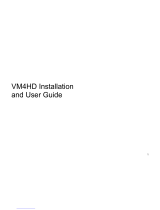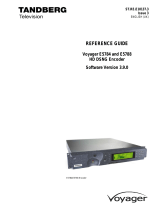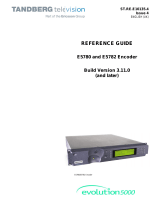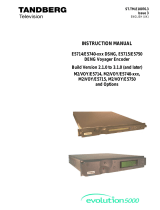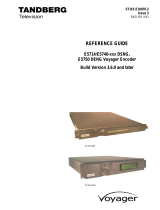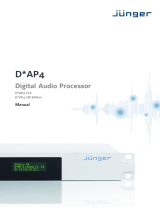Page is loading ...

7700 MultiFrame Manual
7730ADC Component A to D
Revision 1.1.1
Grey background indicate un-implemented or un-tested features
TABLE OF CONTENTS
1. OVERVIEW........................................................................................................................... 1
1.1. FUNCTIONAL DESCRIPTION....................................................................................................2
2. INSTALLATION....................................................................................................................5
2.1. VIDEO IN AND OUT....................................................................................................................5
3. SPECIFICATIONS ................................................................................................................ 6
3.1. ANALOG VIDEO INPUT..............................................................................................................6
3.2. REFERENCE VIDEO INPUT.......................................................................................................6
3.3. ANALOG VIDEO OUTPUT..........................................................................................................6
3.4. SERIAL VIDEO OUTPUT............................................................................................................6
3.5. VIDEO PERFORMANCE (SDI OUTPUTS ONLY) ......................................................................7
3.6. ANALOG AUDIO INPUT (-A4 ONLY).........................................................................................7
3.7. AES AUDIO INPUTS (-AES ONLY) AND OUTPUTS.................................................................7
3.8. ELECTRICAL ..............................................................................................................................7
3.9. PHYSICAL...................................................................................................................................8
4. STATUS LEDS .....................................................................................................................9
4.1. MODULE STATUS LEDS............................................................................................................9
4.2. AUDIO STATUS LEDS................................................................................................................9
5. RGB VIDEO LEVEL CALIBRATION.................................................................................. 10
6. AUDIO BUFFER MANAGEMENT (+S OPTION ONLY)..................................................... 11
7. AUDIO LEVELS, HEADROOM, CLIPPING AND THE BAR GRAPHS (-A4 AND –AES).. 12
7.1. INPUT AUDIO LEVEL CALIBRATION .....................................................................................12
8. AUDIO ALARM CALIBRATION PROCEDURE (-A4 AND –AES) ..................................... 13
8.1. CALIBRATE AUDIO SILENCE DETECTION ...........................................................................13
8.2. CALIBRATE AUDIO PHASE REVERSAL DETECTION..........................................................13
8.3. CALIBRATE AUDIO MONO DETECTION................................................................................14
8.4. DEFINE THE FAULT CONDITION(S).......................................................................................14
9. ON SCREEN MENUS......................................................................................................... 15
9.1. NAVIGATING THE ON SCREEN MENU SYSTEM...................................................................15
9.2. CHANGING TEXT FIELDS........................................................................................................15
9.3. ON SCREEN DISPLAY – MAIN MENU ....................................................................................16
9.4. CONFIGURING THE AUDIO CONTROLS (-A4 AND –AES) ...................................................16
9.4.1. Selecting the Audio Destination Group..............................................................................17
9.4.2. Audio Freeze Mode............................................................................................................17
9.4.3. Additional Audio Delay.......................................................................................................18
9.4.4. Monitoring the Audio Buffer Tracking.................................................................................18

7700 MultiFrame Manual
7730ADC Component A to D
Revision 1.1.1
Grey background indicate un-implemented or un-tested features
9.4.5. Setting the Analog Levels (-A4 only)..................................................................................18
9.4.6. Audio Channels 1 and 2 Processing..................................................................................19
9.4.7. Audio Channels 3 and 4 Processing..................................................................................19
9.4.8. Swapping Channel Pairs....................................................................................................19
9.5. CONFIGURING THE VIDEO CONTROLS................................................................................20
9.5.1. Setting the Video Standard................................................................................................21
9.5.2. Selecting the Input Video Synchronization Source............................................................21
9.5.3. Selects the Action to Take when Input Video Is Missing....................................................21
9.5.4. Genlock Source Selection..................................................................................................22
9.5.5. Setting the Free-Running Frequency.................................................................................22
9.5.8. Setting the Horizontal Phase of the Output Video – NTSC/525 Video...............................22
9.5.9. Setting the Horizontal Phase of the Output Video – PAL-B/625 Video..............................23
9.5.10. Monitoring the Horizontal Delay between the Input and Output Video ..............................23
9.5.11. Setting the Vertical Phase of the Output Video – NTSC/525 Video...................................23
9.5.12. Setting the Vertical Phase of the Output Video – PAL-B/625 Video ..................................23
9.5.13. Monitoring the Vertical Delay between the Input and Output Video...................................23
9.5.14. Monitoring the Audio Buffer Tracking.................................................................................24
9.5.15. Selecting Time Code Type.................................................................................................24
9.5.16. Setting the VITC Line Number – 525 Line Video ...............................................................24
9.5.17. Setting the VITC Line Number – 625 Line Video ...............................................................24
9.6. CONFIGURING THE INPUT VIDEO PROCESSING CONTROLS ...........................................25
9.6.1. Black Level Control............................................................................................................25
9.6.2. Video Level Control............................................................................................................26
9.6.3. Delay Y/G...........................................................................................................................26
9.6.4. Fine Phase.........................................................................................................................26
9.7. CONFIGURING THE BAR GRAPH CONTROLS (-A4 AND –AES) .........................................26
9.7.1. Selecting the Bar Graph Operating Mode..........................................................................27
9.7.2. Setting the Headroom........................................................................................................28
9.7.3. Setting the Bar Graph Type ...............................................................................................28
9.7.4. Setting the PPM Mode and Ballistics.................................................................................29
9.7.5. Setting the VU Display Range............................................................................................30
9.7.6. Setting The Phase Bar Graph Type...................................................................................30
9.7.7. Setting the Bar Graph Error Region...................................................................................30
9.7.8. Setting the Bar Graph Warning Region..............................................................................31
9.7.9. Setting the Level Bar Graph Scale Position.......................................................................31
9.7.10. Setting The Phase Bar Graph Scale Position....................................................................31
9.7.11. Setting The Window And Bar Graph Positions ..................................................................31
9.7.12. Setting the Colours of the Bar Graphs...............................................................................32
9.7.12.1. Setting the Level Bar Graph Region Colour...............................................................32
9.7.13. Setting The Level Bar Graph Size......................................................................................33
9.7.14. Setting the Transparency (Opacity) of Bar Graph Background..........................................33
9.7.15. Setting the Transparency (Opacity) of the Bar Graph Bars................................................33
9.8. CONFIGURING THE ON-SCREEN DISPLAY CONTROLS.....................................................33
9.8.1. Descriptions of the On Screen Windows............................................................................34
9.8.1.1. Video/Audio Status.....................................................................................................34
9.8.1.2. Time Code Window....................................................................................................35
9.8.1.3. Fault Message Windows............................................................................................35
9.8.2. Setting the Position of On Screen Windows ......................................................................36
9.8.2.1. Setting the Horizontal Position of On Screen Windows .............................................36
9.8.2.2. Setting the Vertical Position of On Screen Windows..................................................36

7700 MultiFrame Manual
7730ADC Component A to D
Revision 1.1.1
Grey background indicate un-implemented or un-tested features
9.8.3. Setting the Position of the Bar Graphs...............................................................................36
9.8.3.1. Setting the Horizontal Position of the Bar Graphs......................................................36
9.8.4. Setting the Vertical Position of the Bar Graphs..................................................................36
9.8.5. Selecting What Bar Graphs And Windows To Display.......................................................37
9.8.6. Setting the Text Window Attributes....................................................................................37
9.8.6.1. Turning on the Text Window Backgrounds ................................................................37
9.8.6.2. Setting the Text Window Background Colours...........................................................38
9.8.6.3. Setting the Text Window Background Opacity...........................................................38
9.8.6.4. Setting the Text Window Text Opacity.......................................................................38
9.8.6.5. Setting the Time Code Window Font Size..................................................................38
9.8.6.6. Setting the Status Window Mode...............................................................................39
9.8.7. Setting the Fault Window Attributes...................................................................................39
9.8.7.1. Turning on the Fault Window Backgrounds ...............................................................39
9.8.7.2. Setting the Fault Window Background Colours..........................................................39
9.8.7.3. Setting the Fault Window Background Opacity..........................................................40
9.8.7.4. Setting the Fault Window Text Opacity......................................................................40
9.8.7.5. Setting the Fault Window Font Size...........................................................................40
9.8.7.6. Setting the Blink Mode of the Fault Windows.............................................................40
9.9. GPO CONFIGURATION............................................................................................................41
9.9.1. Frame Status Fault Trigger Condition................................................................................41
9.10. FAULT DEFINITIONS............................................................................................................41
9.10.1. Setting Up How A Fault Is Triggered And How It Is Presented..........................................42
9.10.1.1. Fault Status................................................................................................................42
9.10.1.2. Setting the position of the Fault Windows..................................................................42
9.10.1.3. Setting the Message Associated with a Fault.............................................................43
9.10.1.4. Determining If The Fault Message Will Be Displayed................................................43
9.10.1.5. Setting the Duration of the Fault Condition ................................................................43
9.10.1.6. Determining What Items Will Generate The Fault Condition......................................43
9.10.2. Setting the Fault Window Attributes...................................................................................44
9.10.3. Setting the Loss of Video Duration.....................................................................................44
9.10.4. Setting the Loss of Audio Duration.....................................................................................45
9.10.5. Detecting Audio Over Level Faults.....................................................................................45
9.10.5.1. Setting the Audio Over Level......................................................................................45
9.10.5.2. Setting the Audio Over Duration.................................................................................45
9.10.6. Detecting Audio Silence Faults..........................................................................................45
9.10.6.1. Setting the Audio Silence Level..................................................................................45
9.10.6.2. Setting the Audio Silence Duration.............................................................................46
9.10.7. Detecting Audio Phase Reversal Faults.............................................................................46
9.10.7.1. Setting the Audio Phase Reversal Level....................................................................46
9.10.7.2. Setting the Audio Phase Reversal Duration...............................................................46
9.10.8. Detecting Audio Mono Faults.............................................................................................46
9.10.8.1. Setting the Audio Mono Threshold Level ...................................................................47
9.10.8.2. Setting the Audio Mono Duration ...............................................................................47
9.11. UTILITIES..............................................................................................................................48
9.11.1. Accessing Information About this Module and its Firmware ..............................................48
9.11.2. Saving And Recalling Configurations.................................................................................48
9.11.2.1. Storing Configurations to the User Presets................................................................48
9.11.2.2. Recall Configurations from the User Presets.............................................................48
9.11.3. Initiating a Software Upgrade.............................................................................................49
9.11.4. Restoring the card to its Factory Default Configuration .....................................................49

7700 MultiFrame Manual
7730ADC Component A to D
Revision 1.1.1
Grey background indicate un-implemented or un-tested features
9.12. CLEAR FAULTS AND PEAKS..............................................................................................49
10. JUMPERS........................................................................................................................50
10.1. TERMINATION JUMPERS....................................................................................................50
10.2. REFERENCE VIDEO SELECTOR JUMPER ........................................................................51
10.3. OUTPUT 3 SELECTOR JUMPER.........................................................................................51
10.4. SELECTING WHETHER LOCAL FAULTS WILL BE MONITORED BY THE GLOBAL
FRAME STATUS...................................................................................................................................51
10.5. CONFIGURING THE MODULE FOR FIRMWARE UPGRADES ..........................................52
10.6. SETTING THE COARSE ANALOG AUDIO INPUT GAIN RANGE ......................................52
Figures
Figure 1-1: 7730ADC Block Diagram.................................................................................................................. 3
Figure 1-2: 7730ADC-A4 Block Diagram............................................................................................................ 3
Figure 1-3: 7730ADC-AES Block Diagram ......................................................................................................... 4
Figure 2-1: 7730ADC Rear Panels ..................................................................................................................... 5
Figure 10-1 : Location of Jumpers on 7730ADC Main Board........................................................................... 50
Figure 10-2 : Location of Jumpers on 7735AI Submodule ............................................................................... 50
Tables
Table 4-1: Audio Channel Status LEDs .............................................................................................................. 9
Table 9-1: PPM Bar Graph Characteristics....................................................................................................... 29
Table 9-2: Video/Audio Status Screen Items.................................................................................................... 35
Table 9-3: Methods of turning Windows and Bar graphs On and Off............................................................... 37
Table 9-4: Possible Error Conditions to Produce a Fault.................................................................................. 44

7700 MultiFrame Manual
7730ADC Component A to D
Revision 1.1.1
Grey background indicate un-implemented or un-tested features
REVISION HISTORY
REVISION DESCRIPTION DATE
0.1 Preliminary Oct 03
1.0 First release with a few missing features Nov 03
1.1 Minor changes Mar 04
1.1.1 Corrected NTSC/PAL identification in section 4.1 Apr 07
WARNING: This version contains areas of grey text that are indicative of future
software releases. These sections are to be used as information only
and are subject to change. Some of these features may seem to work
but they have not been completed and have not been verified by
Evertz.

7700 MultiFrame Manual
7730ADC Component A to D
Revision 1.1.1
Grey background indicate un-implemented or un-tested features
This page left intentionally blank

7700 MultiFrame Manual
7730ADC Component A to D
Revision 1.1.1
Grey background indicate un-implemented or un-tested features 7730ADC-1
1. OVERVIEW
The 7730ADC line of component analog video to serial digital converters are broadcast quality A to Ds
with an extensive list of additional features. High quality analog to digital conversion of audio or AES
inputs can be packaged with the video to create an A to D frame synchronizer with audio embedder. In
addition, Evertz fault monitoring processor will analyze and report video and audio problems via an On-
Screen-Display, or remotely via VistaLINK® SNMP.
The Features of the A to D Process are:
10 bit, 54MHz sampling of input video.
Internal processing to maintain 10 bit digital video quality.
Y, Pb, Pr or G, B, R input support.
Black level clamp on all components.
User adjustable input video processing functions: black level control on all 3 components, gain control
on all 3 components, inter-channel delay control in 18 ns increments.
Sync on green or separate sync input.
300mV or 4V separate sync support.
The Features of all 7730ADC’s are:
Three input BNCs for Y, Pb, Pr or G, B, R input.
One sync input BNC for separate sync.
Two SDI 525 or 625, 270 Mb/s component digital video output WITHOUT OSD text or audio bar
graphs.
One combination output that can either be an extra SDI output or composite analog video output.
When configured as a composite analog output it can either be a clean output (no OSD), or have the
OSD text and bar graph graphics for monitoring.
EDH encoding on SDI output.
One combination input BNC that can either be an LTC input or a composite analog reference input
(NTSC or PAL-B). 75 Ohm or high-Z, jumper configurable input impedance.
One frame video synchronizer (with +S option).
Infinitely variable output phase (27MHz clock increments).
Freeze modes: black, freeze, pass.
Menu adjustable free running frequency.
VU/PPM bar graph level Indicators.
Decodes vertical interval time code (VITC) or longitudinal time code (LTC) and “burns” the time code
into the picture.
A comprehensive On Screen display is available to configure the various features of the module.
Flexible configuration of the text and audio bar graph information displays.
An extensive list of error conditions can be monitored and fault conditions can be configured from
these conditions.
On screen messages can be triggered by the configured fault conditions.

7700 MultiFrame Manual
7730ADC Component A to D
7730ADC-2 Revision 1.1.1
Grey background indicate un-implemented or un-tested features
The Features of "-A4" option are:
4 balanced analog audio inputs on 2 removable barrier strips.
High impedance inputs (user supplies termination resistors for other impedances)
Analog audio input levels are adjustable. Jumpers set coarse input levels, fine input levels are set by
software control.
Audio delay equivalent video delay (with +S option).
Additional audio delay of up to 5 seconds.
Audio advance of up to 1 frame less 3 microseconds.
One group (4 channels of audio) is multiplexed on the outgoing digital video.
2 unbalanced AES audio outputs delayed equivalently to the video delay.
75 Ohm coaxial (unbalanced) DARS reference input on BNC.
Loss of video modes: pass audio, mute audio
The Features of "-AES" option are:
75 Ohm coaxial (unbalanced) AES inputs (2) on BNC.
Audio delay equivalent to video delay (with +S option).
Additional audio delay of up to 5 seconds.
Audio advance of up to 1 frame less 3 microseconds.
One group (2 channels of audio) is multiplexed on the outgoing digital video.
2 unbalanced AES audio outputs delayed equivalently to the embedded audio.
75-Ohm coaxial (unbalanced) DARS reference input on BNC.
Loss of video modes: pass audio, mute audio.
Bypass relay protection that allows removing the card without re-wiring AES audio.
1.1. FUNCTIONAL DESCRIPTION
Component analog video is converted to 10 bit parallel data. Inter-channel delay control allows the time-
alignment of the 3 components with 18ns resolution. The over sampled components are then decimated
and colour space converted (if G, B, R format) into Y, Cb, Cr in 4:4:4 format. The Cb and Cr are then
further decimated to create 4:2:2. Gain, black level, and setup removal video processing functions are
performed during the A to D process while colour space conversion is done in the digital world.
In the 7730ADC-A4 version, the audio is converted from balanced analog to digital PCM audio. The
7730ADC-AES, receives the input AES audio and rate converts it to synchronous 48kHz. The digital audio
is then delayed to match the delay experienced by the video in the video synchronizer (with +S option).
This delayed audio (with +S option) is formatted properly and delivered to the user as unbalanced 75 Ohm
AES audio on BNC. It is also formatted into one group of audio and embedded on the SDI output video.
The audio is also processed to extract level and phase information. The CPU creates the level and phase
bar graphs and writes them out to the On Screen display (OSD) memory.
The hardware mixes (keys) the on screen text and bar graphs display information onto the video stream.
This video goes out through a high quality composite encoder with the OSD "burn-ins".
The CPU also gets pushbutton and toggle switch commands from the card edge controls and draws
extensive menus for configuring the operation of the card.
The following block diagrams illustrate the processing blocks.

7700 MultiFrame Manual
7730ADC Component A to D
Revision 1.1.1
Grey background indicate un-implemented or un-tested features 7730ADC-3
P / S
ADC
Control
Colour
Space
Converter
SDI
Formatter
3
Sync In
Status
Module
Ok
1
2
Frame.
Sync.
(+S only) EDH
Encode
Sync
Process
Y/G
Pr/R
Pb/B
Ref In
SDI
Outputs
Composite
Analog
OSD
Monitoring
Video
Mon. Out
or
SDI Out
Sync
Process
7730ADC(+S)
VistaLINK
Interface
Figure 1-1: 7730ADC Block Diagram
P / S
ADC
Control
Colour
Space
Converter
SDI
Formatter Audio
Embedder
3
Sync In
Status
Module
Ok
1
2
Audio Content
Analysis
& Delay
A/D
A/D
A/D
A/D AES
Formatter
-A4 Version only
7730ADC-A4(+S)
Frame.
Sync.
(+S only) EDH
Encode
Sync
Process
Y/G
Pr/R
Pb/B
Ref In
SDI
Outputs
Composite
Analog
OSD
Monitoring
Video
Mon. Out
or
SDI Out
Sync
Process
DARS
Reference
4
Balanced
Analog
Audio
Inputs
2 AES
Outputs
VistaLINK
Interface
Figure 1-2: 7730ADC-A4 Block Diagram

7700 MultiFrame Manual
7730ADC Component A to D
7730ADC-4 Revision 1.1.1
Grey background indicate un-implemented or un-tested features
P / S
ADC
Control
Colour
Space
Converter
SDI
Formatter
3
Sync In
Status
Module
Ok
1
2
Frame.
Sync.
(+S only) EDH
Encode
Sync
Process
Y/G
Pr/R
Pb/B
Ref In
SDI
Outputs
Composite
Analog
OSD
Monitoring
Video
Mon. Out
or
SDI Out
Sync
Process
7730ADC-AES(+S)
Audio
Embedder
-AES Version only
2 AES
Inputs
DARS
Reference
Audio content
analysis and
Delay
75
AES
Formatter
Sample Rate
Converters
2 AES
Outputs
VistaLINK
Interface
Figure 1-3: 7730ADC-AES Block Diagram

7700 MultiFrame Manual
7730ADC Component A to D
Revision 1.1.1
Grey background indicate un-implemented or un-tested features 7730ADC-5
2. Installation
The 7730ADC modules come with a companion rear plate and occupies one or two slots in the 7700FR
frame. Figure 2-1 shows a picture of each of the rear panels. For information on mounting the rear plate
and inserting the module into the frame see section 3 of the 7700FR chapter.
The 7730ADC card must be inserted into slots with the correct rear panel. Some cards have physical
differences and some have functional differences.
Figure 2-1: 7730ADC Rear Panels
2.1. VIDEO IN AND OUT
Connect a source of component analog video to the top BNCs labeled ANALOG IN. If there is sync on the
Y/G channel, there is no need to connect anything to the SYNC input. Connect a reference black signal to
the REF IN BNC (+S option only). Alternatively, if you have a 7700FR-G frame, this card can be
configured to accept one of the reference signals provided to the frame. Converted video with embedded
audio and EDH encoding is available on the SDI OUT BNCs. Composite analog video with text and audio
bar graphs are available on the MON OUT output BNC, or after the card has been configured, this may be
an additional SDI output. If the card is not present or the power is off, there will be nothing on any of the
outputs.

7700 MultiFrame Manual
7730ADC Component A to D
7730ADC-6 Revision 1.1.1
Grey background indicate un-implemented or un-tested features
3. SPECIFICATIONS
3.1. ANALOG VIDEO INPUT
Standards: Y, Pb, Pr or G, B, R : SMPTE/EBU N10, Betacam, MII, and other
NTSC related
Number of Inputs: 1
Connector: BNC per IEC 169-8
Signal Level: 1V nominal
Frequency Lock Range: ±75ppm from nominal
Input level control range: ±15%
Black level control range: ±5 IRE
Input Impedance: 75 Ohm
Return Loss: >30dB to 30MHz
3.2. REFERENCE VIDEO INPUT
Standard: NTSC, SMPTE 170M
PAL, ITU624-4
Number of Inputs: 1
Connector: BNC per IEC 169-8
Signal Level: 1V nominal
Frequency Lock Range: ±75ppm from nominal
Input Impedance: 75 Ohm or High impedance (jumper selectable)
Return Loss: >35dB to 10MHz
3.3. ANALOG VIDEO OUTPUT
Standard: NTSC, SMPTE 170M
PAL, ITU624-4
Number of Outputs: 1
Connector: BNC per IEC 169-8
Signal Level: 1V nominal
Output Impedance: 75 Ohm
Return Loss: >35dB to 10MHz
3.4. SERIAL VIDEO OUTPUT
Standard: SMPTE 259M-C – 525 or 625 line component.
Number of Outputs: 3
Connector: BNC per IEC 169-8
Signal Level: 800mV nominal
DC Offset: 0V ±0.5V
Rise and Fall Time: 900ps nominal
Overshoot: <10% of amplitude
Return Loss: >15dB to 270MHz
Embedded Audio: SMPTE 272M-A

7700 MultiFrame Manual
7730ADC Component A to D
Revision 1.1.1
Grey background indicate un-implemented or un-tested features 7730ADC-7
3.5. VIDEO PERFORMANCE (SDI outputs only)
Frequency Response: <±??dB (100kHz to 4.1MHz)
Noise Floor: < -??dBrms (G, B, R, 15kHz to 5MHz)
< -??dBrms (Y, Pb, Pr, black video, 15kHz to 5MHz)
Inter-channel Delay: <±9ns
Minimum Delay: 3 usec
Maximum Delay: 1 frame plus 3 usec
3.6. ANALOG AUDIO INPUT (-A4 only)
Number of Inputs: 4
Type: Balanced analog audio
Connector: Removable terminal strip
Input Impedance: 20kOhm minimum (differential)
Sampling Frequency: 48kHz
Signal Level: 0dB FS => 18 or 24dBu (jumper selectable)
Level Control Range: +/- 10dB
Frequency Response: +/- 0.1dB (20Hz to 20kHz) (broadcast quality)
SNR: 100dB with input at -0.5dBFS
THD+N: <0.001% (>100dB) @ 1kHz, -0.5 dB FS (rev 2)
<0.001% (>100dB) @ 20Hz to 20kHz, -0.5 dB FS (input video locked to
genlock video)
CMRR >100dB @ 1kHz
3.7. AES AUDIO INPUTS (-AES only) AND OUTPUTS
Number of Inputs: none on –A4 versions, 2 on –AES versions
Number of Outputs: 2
Input Standard: SMPTE 276M, single ended synchronous or asynchronous PCM AES
Output Standard: SMPTE 276M, single ended synchronous AES
Connectors: BNC per IEC 169-8
Resolution: 24 bits
Sampling Rate: 32kHz to 48 kHz on inputs, synchronous 48kHz on outputs
User Bits: Transferred to output in a non-real-time, non-block-contiguous manner
Minimum I/O Delay: 2.1msec on –A4 versions
2.5msec on –AES versions
Maximum I/O Delay: 5 seconds
3.8. ELECTRICAL
Voltage: + 12VDC
Power: 11 Watts ADC + 9 Watts (-A4 option) = 20 Watts total.
EMI/RFI: Complies with FCC Part 15, class A and EU EMC directive.

7700 MultiFrame Manual
7730ADC Component A to D
7730ADC-8 Revision 1.1.1
Grey background indicate un-implemented or un-tested features
3.9. PHYSICAL
7700 frame mounting:
Number of slots: 1 for non-audio versions
2 for audio versions (-AES, -A4)
Stand Alone Enclosure:
Dimensions: 14 “ L x 4.5 “ W x 1.9 “ H
(355 mm L x 114 mm W x 48 mm H)
Weight: approx. 1.5 lbs. (0.7 Kg)

7700 MultiFrame Manual
7730ADC Component A to D
Revision 1.1.1
Grey background indicate un-implemented or un-tested features 7730ADC-9
4. STATUS LEDs
4.1. MODULE STATUS LEDS
MODULE STATUS: This Green LED will be on when the module is operating properly.
LOCAL FAULT: This Red LED makes it easy to identify one module in a frame that is missing an
essential input or has another fault.
The LED will blink on and off if the microprocessor is not running.
The LED will be on when there is a fault in the module power supply or a user
configurable error condition exists.
NTSC/PAL: The 525/625 Green LEDs (525 on the top, away from the PCB and 625 on the
bottom, closest to the PCB) will indicate the video line standard of the
component analog input. If video is removed, both LEDs will go off.
GENLOCKED: This Green LED is on solid if the user selected genlock source (either external
input or from the frame) is present and the user has turned on genlocking.
It is flashing if the user has turned on genlocking and the selected genlock
source is not present.
It will be off if the user has turned genlocking off.
4.2. AUDIO STATUS LEDS
Four LEDs located on the lower end of the module (near the card extractor) indicate which audio channels
are present. Audio channel 1 LED is located closest to the center of the module. Analog audio (on -A4
versions) presence is determined with the silence detector. Digital audio (on –AES versions) presence is
determined by the AES receiver lock indicator as well as the silence detector. If the audio is not silent, the
LED will be on. For more details, see the sections associated with controlling and calibrating the silence
detector.
Audio
LED Colour Audio Channel Status
1 Off No channel 1 present.
Green Channel 1 present.
2 Off No channel 2 present.
Green Channel 2 present.
3 Off No channel 3 present.
Green Channel 3 present.
4 Off No channel 4 present.
Green Channel 4 present.
Table 4-1: Audio Channel Status LEDs

7700 MultiFrame Manual
7730ADC Component A to D
7730ADC-10 Revision 1.1.1
Grey background indicate un-implemented or un-tested features
5. RGB VIDEO LEVEL CALIBRATION
Calibrating the DC (black) level and gain (video level) of all 3 components can be a challenge when
inputting RGB video. When converting RGB to YCbCr, a change in any one of the input components will
have an effect in all three of the output components. This is by nature of the colour space conversion
process.
To aid in the calibration, special modes have been incorporated to isolate the processing functions (black
or DC level adjustment and video level or gain control). The colour space converter is re-programmed to
pass the components straight through and one input component is routed to the Y channel of the output
video. This will allow the calibration of a component, independent of the others. The procedure is as
follows:
1. Select appropriate video standard (RGB mode).
2. Input calibrated 100% RGB colourbars.
3. Go into Input Video Processing menu and start adjusting the Black Level Y/G. Note that the Green
signal is routed to the Y channel output and that the Cb and Cr channels have been set to black.
Using a digital waveform monitor, adjust the Black Level Y/G to set black at 64 (40Hex).
4. Adjust the Video Level Y/G to set white to 940 (3ACHex).
5. Repeat steps 3 and 4 with the Blue and Red channels.
6. Leave the Input Video Processing menu and verify the calibration with the digital waveform
monitor. The lightning display is the best because it shows you the relationship between all three
components.

7700 MultiFrame Manual
7730ADC Component A to D
Revision 1.1.1
Grey background indicate un-implemented or un-tested features 7730ADC-11
6. AUDIO BUFFER MANAGEMENT (+S OPTION ONLY)
The audio is delayed, through a large memory buffer, by the same time value as experienced by the video
through the video frame synchronizer. This is done to maintain a consistent video/audio relationship.
Unfortunately, when the video frame buffer drops or repeats frames of video, we can not do the same with
the audio. The rate of the ingoing audio data is changed and over a period of time, the buffer is returned to
a value that matches the video. A sample rate converter is used to change the rate of the incoming AES
on the -AES version while the 48kHz sampling clock is changed slightly from it's nominal value on the
analog audio input (-A4) version. This method is also used when video is first applied or there is a sudden
change in either the input video phase or genlock video phase.
When the audio buffer delay needs to be changed, there are two rates used; +/- 1% and +/- 30ppm.
Initially, a 1% rate change is used to quickly match the audio delay to the video delay. This correction will
only take a couple of seconds but will produce a pitch change. The pitch change will be discernable,
particularly on sustained musical notes. When the video/audio delays are close to each other and only
small corrections are required, the audio buffer will be adjusted with a rate change of 30ppm (30 Parts-
Per-Million is equivalent to 0.003%). This rate change will produce a pitch change that is near the
threshold of where a human can detect it and should not be discernable with normal content.
Unfortunately, the audio buffer management relies on a sample rate converter (-AES versions only) to
adjust the audio buffer size. This precludes the synchronization of non-PCM AES data (i.e. Donly-E). In
the future, a non-sample rate converter mode may be available.
Audio A to D converters and sample rate converters have inherent delays that are much longer than what
the minimum acceptable video I/O delay is. To allow the user to operate the video synchronizer with small
video delays, we will hold the audio buffer delay at it's minimum value when the video is less than this
minimum.

7700 MultiFrame Manual
7730ADC Component A to D
7730ADC-12 Revision 1.1.1
Grey background indicate un-implemented or un-tested features
7. AUDIO LEVELS, HEADROOM, CLIPPING AND THE BAR GRAPHS (-A4
and –AES)
This section contains notes to understand how the 7730ADC-A4 relates analog audio levels, digital audio
levels, and the displayed bar graph levels. Before you can calibrate the audio analog to digital converter,
you must know a couple of system issues specific to your application. What is your analog reference level
and how much headroom do you want to have in the digital audio signal? By adding these two values
together, you will get the analog input level that will just begin to saturate the digital word (This is the
highest level that can be represented without distortion with the digital numbers). This level is called 0dB
FS (FS stands for "full scale"). For instance, if your analog program reference level is 4dBu and you want
20dB of headroom in the "digital world", then 0dB FS will correspond to an analog level of 24dBu. Once
the audio input level is calibrated, when you apply a 4dBu analog signal, the digital level will be –20dB FS.
The SDI embedded audio, the AES output audio and the bar graphs are all based on the digital quantized
signal. The AES/EBU bar graph ballistics mode is scaled to 0dB FS while the other modes have user
selectable headroom. For this reason, use the AES/EBU mode for calibrating input levels.
7.1. INPUT AUDIO LEVEL CALIBRATION
The analog audio input circuitry has two gain control stages before the audio is digitized; a jumper settable
coarse range, and a software (menu system) control. One of the two coarse ranges is optimized for when
peak audio levels are above 18dBu and one for levels below. The jumpers, when not installed, allow input
levels of up to 24dBu. When the jumpers are installed, best performance is achieved when input peak
levels are below 18dBu. The OSD menu system has independent +/- 10dB audio level control of all four
channels (refer to section 9.4.5 for OSD control details).
The following is an example calibration procedure:
1. Take your analog program reference level and add the amount of desired headroom in the digital
signal (SMPTE standard is 20dB). If this number is greater than 18dBu, then remove the 8 jumpers
near the rear of the 7735AI-master card of the 7730ADC-A4 module. If the number is less than
18dBu, then install the 8 jumpers.
2. Apply an analog audio signal of the level calculated above.
3. Apply component analog video to the "ANALOG IN" BNCs.
4. Monitor either the embedded audio or the output AES audio with appropriate level measuring gear.
5. Adjust the level adjust controls in the audio menu so that the digital level just starts to clip.
6. Verify by applying program reference level. The bar graphs should read a level that is below 0dB
FS by the desired headroom level.
More information:
Without front-end jumpers in place (common +24 dBu setting) and 0 dB gain control, the conversion will
transform +24 dBu analog input to 0 dBFS digital signal. Gain control will allow adjustment of this setting
+/-10 dB in 0.5 dB increments (refer to section 9.4.5 for OSD control details). The user has to be aware
that the front-end analog amps will saturate (clip) at +27 dBu independently of adjustable gain/attenuation
stage and the ADC stage.
With "+18 dBu" jumpers in place and 0 dB gain control, the conversion will transform +18 dBu analog input
to 0 dBFS digital signal. Gain control will allow adjustment of this setting +/-10 dB in 0.5 dB increments
(see Setting the Analog Levels for OSD control details). The user has to be aware that the front-end
analog amps will saturate (clip) at +21 dBu independently of adjustable gain/attenuation stage and the
ADC stage.

7700 MultiFrame Manual
7730ADC Component A to D
Revision 1.1.1
Grey background indicate un-implemented or un-tested features 7730ADC-13
8. AUDIO ALARM CALIBRATION PROCEDURE (-A4 and –AES)
This section contains a detailed description on setting the various audio warning/error detection
parameters.
Some of the audio alarm detection algorithms are dependent on the state of other audio alarm detectors.
For instance, the mono detection algorithm will not use periods of silence as determined by the silence
detection. For this reason, the following sequence should be used to calibrate the audio alarms. The
items in italics refer to menu items in the ADC. See section 9.10 for a complete description of the fault
definition menu items.
8.1. CALIBRATE AUDIO SILENCE DETECTION
1. Supply the card with your facility’s noisiest audio feed without any audio program material present.
This will be a baseline noise level to calibrate the silence detector.
2. Turn off all sources of errors in a Fault Condition and assign Audio Silence as the only error. Also,
make sure that you set the Fault Duration to a small number of frames so that you will see when the
error condition disappears.
3. Set the Silence Duration to 0.5 sec so that you can see the results of adjusting the Silence Level
parameter without getting confused with the detection time.
4. Adjust the audio Silence Level until the Fault Condition begins to go active. This will be the noise floor
level. Raise the Silence Level a few dB to make the detector insensitive to this noise level.
5. Set the Silence Duration to a time appropriate to your application. This should be set to a value longer
than your worst case acceptable quiet period.
8.2. CALIBRATE AUDIO PHASE REVERSAL DETECTION
1. Supply the card with a stereo signal that has the phases reversed. Make sure that the material is
typical of normal content for this channel.
2. Turn off all sources of errors in a Fault Condition and assign Phase Reversal as the only error. Also,
make sure that you set the Fault Duration to a small number of frames so that you will see when the
error condition disappears.
3. Set the Phase Reversal Duration to 0.5 sec so that you can see the results of adjusting the Phase
Reversal Level without getting confused with the detection time.
4. Adjust the Phase Reversal Level so that the Fault Condition detects the phase reversal.
5. Set the Phase Reversal Duration to a time period appropriate to your application.
" Warning: Periods of silence (below the Silence Level) will extend this duration. In other
words, periods without audio content are not included in the phase reversal detection.
"
Warning: Stereo material with long periods of dissimilar left/right content (i.e. music with
plenty of panning) may cause the phase reversal detector to fire. It is best to set the Phase
Reversal Duration to a value larger than what you would expect.

7700 MultiFrame Manual
7730ADC Component A to D
7730ADC-14 Revision 1.1.1
Grey background indicate un-implemented or un-tested features
8.3. CALIBRATE AUDIO MONO DETECTION
1. Supply the card with a stereo signal that originated from mono material and that has a large amount of
un-correlated noise added to each channel. This will allow you to set the Mono Threshold to a value
that will detect the mono condition in the presence of noise.
" Warning: Make sure that the material is in-phase. Mono material will not be detected if it
is out of phase.
2. Turn off all sources of errors in a Fault Condition and assign Mono as the only error. Also, make sure
that you set the Fault Duration to a small number of frames that you will see when the error condition
disappears.
3. Set the Mono Duration to 0.5 sec so that you can see the results of adjusting the Mono Threshold
Level without getting confused with the detection time.
4. Adjust the Mono Threshold Level so that the Fault Condition detects the mono material in the
presence of noise.
5. Set the Mono Duration to a time period appropriate to your application.
" Warning: Periods of silence (below the Silence Level) will extend this duration. In other
words, periods without audio content are not included in the mono detection.
"
Warning: Stereo material with long periods of similar left/right content (i.e. talking heads
in a news cast) may cause the mono detector to fire. It is best to set the Mono Duration
to a value larger than what you would expect.
8.4. DEFINE THE FAULT CONDITION(S)
1. A Fault Condition is defined as a group of one or more problems grouped together that will create a
fault when any one of the problems exist. Decide what grouping of error conditions will generate a fault
by setting the appropriate condition to Yes in the Fault Condition menu.
2. Set the Fault Duration to either Until Reset or to a time value. This is how long the condition will stay
active after the conditions generating the fault go away.
3. Configure a Fault Message. Enter the text to display on screen, it's H and V position, and it's
characteristics (opacity, colour, etc).
4. Assign the Fault Condition to an output contact closure (GPO) if it is desired.
/
